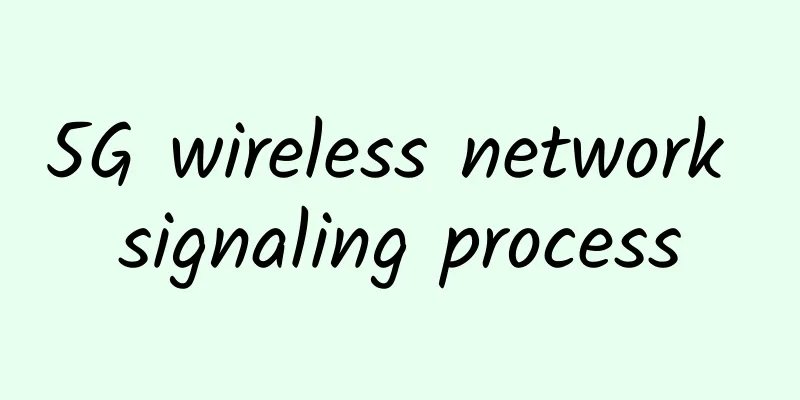5G wireless network signaling process

|
1. 5G initial access 1. Overview of powering on and accessing the network Initial wireless access: When the UE is powered on, its first task is to find the wireless network and establish a connection with it, which requires the following steps;
ATTACH:
Public process:
2. Overview of the initial access process In NSA networking, gNodeB does not need to broadcast RMSI. The content of RMSI is sent to UE via RRC signaling (sent by LTE) before UE starts accessing NR. 3. System message broadcast overview NR synchronization and system message broadcasting include: PSS/SSS, PBCH, RMSI and QSI, etc.;
To support massive MIMO, all broadcast channels and signals support beam scanning. 4. Broadcast channel beam scanning The broadcast beam is designed to have a maximum of N fixed-direction beams. The broadcast beam coverage of the cell is completed by sending different beams at different times. The UE scans each beam to obtain the optimal beam and completes synchronization and demodulation of system messages. 5. MIB information content One of the most important functions of 5G MIB is to inform UE how to obtain SIB1 messages. Ten tables are defined in 38.213. The UE needs to determine which table to select based on the subcarrier spacing of the SSB, the SubcassierSpaceCommon parameter in the MIB, and the minimum bandwidth of the cell corresponding to the frequency band, and then select which row in the table through the high 4 bits in pdcch-ConfigSIB1. Number of RB CORESET: This parameter defines the number of RBs in the CORESET in the initial BWP, and also defines the bandwidth of the initial BWP. Currently, the protocol defines three bandwidths: 24, 48, and 96 RB. Number of Symbols CORESET: This parameter defines the number of symbols in the CORESET in the initial BWP, and the value range is 1-3; offset(RBs) This parameter defines the offset between the starting RB of CORESET in the initial BWP and RB0 of SSB, which defines the frequency domain position of the initial BWP. 6. MIB information element 7. SIB1 cell analysis 8. SIB1 Message The SIB1 message mainly broadcasts the basic information required by the UE when it initially accesses the network, including initial SSB related information, initial BWP information, downlink channel configuration, etc. SIB1 will broadcast the number of SSBs actually sent; UE needs to rate match SSBs based on this information; In addition, SIB1 also broadcasts cell-specific ratio information. The UE needs to obtain the SIB1 message at the corresponding position based on the position of the SSB index it has searched. In NSA, SIB1 messages are not broadcast; the content carried by SIB1 is sent to the UE via LTE in the RRC reconfiguration message. 9. Other broadcast messages Including SIB2-SIBn QSI is carried on PDSCH Support periodic broadcast
SIBs with the same transmission period can be mapped to different SI messages. Support ODOSI broadcast UE in RRC CONNECTED state requests and transmits OSI through dedicated signaling. The specific process is to be clarified by the protocol. UE in RRC IDLE or RRC INACTIVE state; if SIB1 indicates support for ODOSI, request OSI through MSG1, otherwise, request OSI through MSG3, the specific details are to be clarified by the protocol; 10. Random Access The events that trigger RA are as follows:
The random access process in NR is basically the same as that in LTE. The access process is initiated by sending a preamble. The access process is also divided into contention access and non-contention access (distinguished by using different types of preambles) 11. Random Access Conflict Resolution 12. Uplink synchronization in random access The UE establishes or restores uplink synchronization through random access. Newly powered-on UEs, idle UEs, out-of-sync UEs, and switched-in UEs all complete uplink synchronization with the gNodeB through random access and enter the synchronized state. The gNodeB obtains the timing offset on the UE side based on the Random Access Preamble measurement and carries it to the UE through the RAR message. 2. 5G NSA signaling process 1. NSA overall process 2. NSA downlink data offload 3. NSA auxiliary station adding process 4. Measurement control and measurement report submission ▼Network Management Cell 5. Add auxiliary station 6. Air interface auxiliary station adding signaling process 7. Random access on the gNR side After the UE sends the RRC integrity reconfiguration on the LTE side, it will try to access the NR; The following three signals cannot be tracked through LMT because they are layer 1 signals. In NSA mode, the NR air interface has no SRB, only DRB, and all TTC signaling can only be transmitted through LTE. In the figure below, MSG3 only has MAC CE and does not include RRC signaling. 8. Auxiliary station adding process 9. Transmission address update on the core network side 10. NSA auxiliary station modification (triggered by the main station) 11. NSA auxiliary station modification (auxiliary station trigger) 12. Auxiliary station release triggered by the master station 13. Auxiliary station release triggered by auxiliary station 3. 5G Mobility Signaling Process |
>>: If you understand long-distance relationships, you will understand how to configure switches.
Recommend
The digitalization journey of Hengshun
[[395022]] In 1840, during the reign of Emperor D...
ZJI: Korean independent server starting from 440 yuan/month, 2*E5-2620/16G memory/240G SSD/10M (CN2+BGP) bandwidth
Those who need a Korean server can pay attention ...
The Ministry of Industry and Information Technology interprets the three-year special action plan for increasing IPv6 traffic, requiring home terminals to support
[[410842]] The Ministry of Industry and Informati...
Network packet loss troubleshooting solution
1. Location and processing of network packet loss...
How AI and software are driving 5G data center transformation
Today, we are witnessing a huge period of innovat...
Low Power Wide Area Network (LPWAN) Technology – Benefits and Testing Challenges
What is LPWAN? The Internet of Things (IoT) refer...
Operators' 2G/3G network withdrawal may accelerate
As 4G coverage deepens and 5G commercial scope co...
Sub-band full-duplex, a compromise for the 5G dream?
Hello everyone, I am Mayfly. In this issue, let’...
Double 11 Carnival, drink this bowl of "traffic control" soup
[[350322]] As the Double 11 shopping festival app...
5G infrastructure scale leads the world, accelerating the implementation of 5G applications is the key to future development
After more than a year of commercial use, China h...
Huawei Chairman Liang Hua: Focus on ICT infrastructure platforms and create a fertile soil for ecological innovation
On April 22, Huawei Chairman Liang Hua shared his...
5G applications drive cellular IoT module market growth
Global cellular IoT module shipments are expected...
How to build a strong network during the COVID-19 pandemic?
[[343306]] Maintaining a resilient network with m...
Is it necessary to upgrade from 4G to 5G mobile phone now?
As 5G network coverage continues to expand rapidl...









